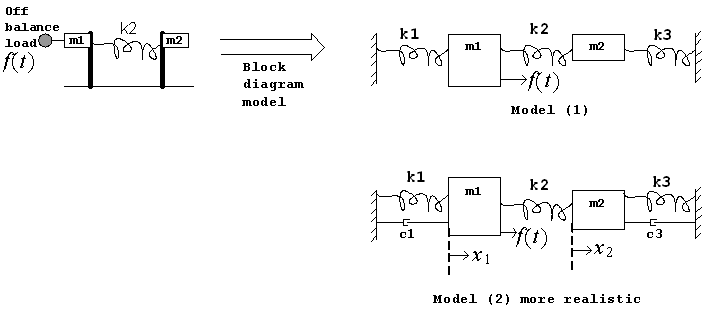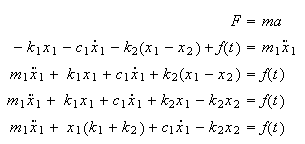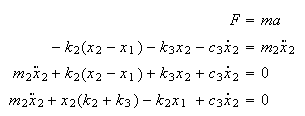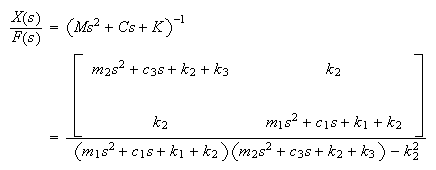
LAB #6 report. MAE 106. UCI. Winter 2005
Nasser Abbasi, LAB time: Thursday 2/17/2005 6 PM

Free diagram for model (2) is the following (assuming m1 is moving to right
faster than
m2)

 Now
derive equations. Take right to be positive.
Now
derive equations. Take right to be positive.
For m1:

For m2:

determine transfer function

Write the dynamic equations in matrix form, we get

Above can be written as

Hence , taking laplace transform we get

Now,



Hence

Now

But for the above,


Hence

i.e.
and

Let
 hence
hence

 will not move
when
will not move
when
but
 implies
implies
 .
i.e.
.
i.e.
 .
But this is the sum of 2 positive quantities. So it is only possible to sum to
zero only when each quantity itself is zero. i.e.
.
But this is the sum of 2 positive quantities. So it is only possible to sum to
zero only when each quantity itself is zero. i.e.

But for non zero
 this means that
this means that
 .
But
.
But
 (the samping) is not zero, since we do have damping in the systems, hence it
is not possible
that
(the samping) is not zero, since we do have damping in the systems, hence it
is not possible
that . In otherwords, there will not be an isolation fequency, and
. In otherwords, there will not be an isolation fequency, and
 will always be non-zero.
will always be non-zero.
But if
 is very small, then
is very small, then
 and in this case
and in this case
 when
when
 or when
or when

Need to derive a mathematical model. First step is to make a block diagram as
follows.


There are 2 motions. One rotational about the center of mass, and one translation, up and down.
Free body diagrams
are

Now the equation of motion for the rotational motion is

But

Hence we get for small
 ,
using
,
using


For the translation motion,

hence

Write the above in matrix form, we get

Take laplace transform we get
Let



Hence above matrix equation can be written as

Take laplace transform, we get

 where
where
 is the
is the
 identity matrix.
identity matrix.
let
 we get
we get

multiply both side by
 we get
we get

i.e.

Which is what we are required to show.








Hence

Hence the natural frequency for the linear (translation) motion is